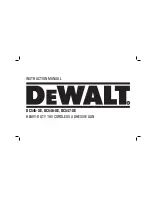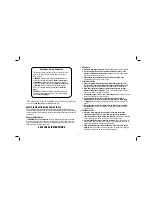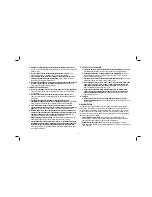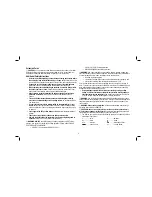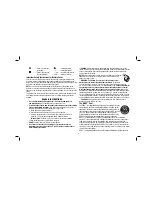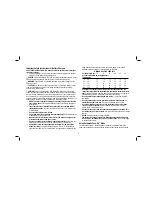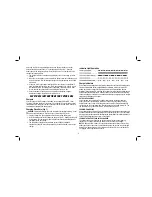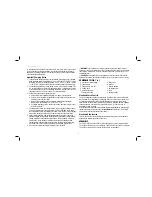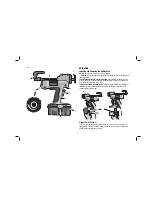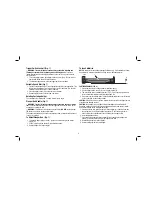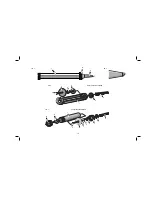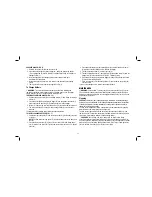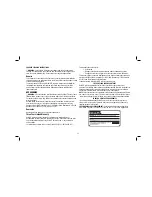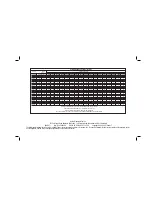
4
DANGER:
Electrocution Hazard. Never attempt to open the battery pack for any
reason. If battery pack case is cracked or damaged, do not insert into charger. Electric
shock or electrocution may result. Damaged battery packs should be returned to
service center for recycling.
NOTE:
Battery storage and carrying caps are provided for use whenever
the battery is out of the tool or charger. Remove cap before placing
battery in charger or tool.
WARNING: Fire Hazard. Do not store or carry battery so that
metal objects can contact exposed battery terminals.
For example,
do not place battery in aprons, pockets, tool boxes, product kit boxes, drawers,
etc., with loose nails, screws, keys, etc. without battery cap.
Transporting batteries
can possibly cause fires if the battery terminals inadvertently come in contact
with conductive materials such as keys, coins, hand tools and the like.
The US
Department of Transportation Hazardous Material Regulations (HMR) actually prohibit
transporting batteries in commerce or on airplanes (i.e., packed in suitcases and
carry-on luggage) UNLESS they are properly protected from short circuits. So when
transporting individual batteries, make sure that the battery terminals are protected
and well insulated from materials that could contact them and cause a short circuit.
CAUTION:
Battery pack must be securely attached to tool. If battery pack is
detached, personal injury may result.
The RBRC™ Seal
The RBRC™ (Rechargeable Battery Recycling Corp oration) Seal on the
nickel cadmium and nickel metal hydride batteries (or battery packs)
indicate that the costs to recycle these batteries (or battery packs) at
the end of their useful life have already been paid by D
E
WALT. In some
areas, it is illegal to place spent nickel cadmium and nickel metal
hydride batteries in the trash or municipal solid waste stream and the
RBRC program provides an environmentally conscious alternative.
RBRC™ in cooperation with D
E
WALT and other battery users, has established
programs in the United States and Canada to facilitate the collection of spent nickel
cadmium and nickel metal hydride batteries. Help protect our environment and
conserve natural resources by returning the spent nickel cadmium and nickel metal
hydride batteries to an authorized D
E
WALT service center or to your local retailer for
recycling. You may also contact your local recycling center for information on where
to drop off the spent battery.
RBRC™ is a registered trademark of the Rechargeable Battery Recycling Corporation.
.............. Class I Construction
.............earthing terminal
...................
(grounded)
.............safety alert symbol
............... Class II Construction
…/min .......revolutions per minute
...................
(double insulated)
BPM ..........beats per minute
Important Safety Instructions for Battery Packs
Your tool uses a D
E
WALT battery pack. When ordering replacement battery packs,
be sure to include catalog number and voltage. Extended Run-Time battery packs
deliver more run-time than standard battery packs. Consult the chart at the end of this
manual for compatibility of chargers and battery packs.
NOTE:
Your tool will accept either standard or Extended Run Time battery packs.
However, be sure to select proper voltage. Batteries slowly lose their charge when
they are not on the charger, the best place to keep your battery is on the charger at all
times.
The battery pack is not fully charged out of the carton. Before using the battery pack
and charger, read the safety instructions below. Then follow charging procedures
outlined.
READ ALL INSTRUCTIONS
•
Do not incinerate the battery pack even if it is severely damaged or is
completely worn out.
The battery pack can explode in a fire.
•
A small leakage of liquid from the battery pack cells may occur under extreme
usage or temperature conditions.
This does not indicate a failure. However, if
the outer seal is broken and this leakage gets on your skin:
a. Wash quickly with soap and water.
b. Neutralize with a mild acid such as lemon juice or vinegar.
c. If battery liquid gets into your eyes, flush them with clean water for a
minimum of 10 minutes and seek immediate medical attention.
(
Medical Note:
The liquid is 25–35% solution of potassium hydroxide.)
• Charge the battery packs only in D
E
WALT chargers.
•
DO NOT
splash or immerse in water or other liquids.
• Do not store or use the tool and battery pack in locations where the
temperature may reach or exceed 40
˚
C (105°F) (such as outside sheds or
metal buildings in summer).
Summary of Contents for DC545-XE
Page 1: ...DC545 XE DC546 XE DC547 XE HEAVY DUTY 18V CORDLESS ADHESIVE GUN INSTRUCTION MANUAL ...
Page 2: ......
Page 15: ...13 ...

